|
The Wirgin company was founded in the 1920s in Wiesbaden, Germany, by the four Wirgin brothers, who were immigrants from Poland. They built several folding cameras before venturing out in miniature cameras, as cameras smaller than medium format were called, like the Gewirette and Edinex. Here the story takes a dramatic turn. The Wirgin brothers were of Jewish origin and became the subject of increasing harrassment. In 1938 they fled Germany via Switzerland to the USA. The company was confiscated and produced cameras under the name Adox. During the war production stopped and the factory was partially destroyed during Allied Forces bombing raids.
After the war Henry Wirgin returned to reclaim his company and carried on where he left off, building Edinex cameras and later moving into SLRs, the Edixa Reflex. Adox also continued to build cameras. The Wirgin company existed till 1972.
Gewirette v.1
The Wirgin Gewirette was a cute little camera with a collapsible lens that produced 3x4 cm negatives on 127 roll film. The first version was made around 1932. It had a small viewfinder in the middle of the top plate but lacked the accessory shoe present on later versions. The top plate was black and could be removed to load film, it was unlocked by rotating the right knob marked 'Z'. The left knob marked 'F' was the wind knob. Two red spy windows were present at the back of the camera.
The Gewirette could be found with a wide variety of lenses and shutters, including Ludwig Victar or Schneider Radionar lenses, and dial-set Vario, Pronto, Ibsor or rim-set Compur or Prontor II shutters. In fact, I don't think I have ever seen any early Gewirette's that were completely identical. Although most had front-cell focussing lenses, examples with a helical focus unit can also be found.

Early example of the first Gewirette model, here with E. Ludwig.Lausa-Dresden "Victar" Anastigmat 50mm f/2.9 lens (a lot of info to be written on such a small lens!) in dial-set self-cocking Pronto shutter with delayed action device (the red lever). I am not quite sure when dial-set shutters were replaced by the more commonly known rim-set shutters, but the dial-set Pronto was advertised until at least until 1931, even though rim-set Compurs were already available by 1929.

|
Another early example, this time with Gewironar Anastigmat f/3.5 lens in Vario dialset shutter.
|
|
You'd be forgiven if you identified this as a Nagel Pupille, but it is in fact a Gewirette v.1 with Schneider Radionar lens in Compur shutter. The lens serial number can be dated to 1932. The viewfinder is not original but probably borrowed from a Nagel Pupille, as it was slightly modified to make it fit. The presence of a focussing helicoid is also uncommon. This adds to the confusion with the Pupille, but on the latter the helicoid was on the body, whereas on Gewirettes it was at the base of the shutter.
|
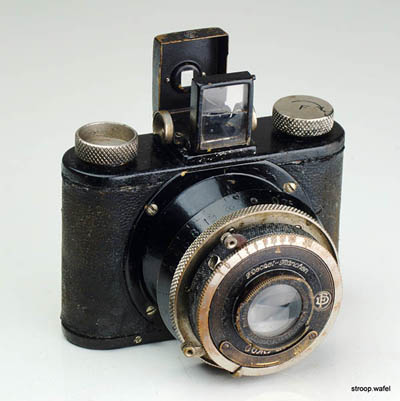
|
Gewirette v.2
The second version of the Gewirette included an accessory shoe and therefore the viewfinder moved to the left. The shutter received two grips on either side to assist pulling out the collapsible lens. On the back were metal covers for the red film windows, which were missing on the first version. It could be found with a black or metal top plate. A considerable range in shutter and lens combinations existed. Shutters were most commonly Vario, Prontor II or Compur. Lenses could be anything like Schneider Radionar, Steinheil Cassar, Meyer Trioplan, Rodenstock Trinar or the own branded Wirgin Gewironar, or even a Schneider Xenon.
A transitional model was also produced. It did not yet have spy window covers or grips beside the lens and was still painted black, but it did already have an accessory shoe.

A very rare 'transitional' Gewirette v.2 version finished in black paint with an uncoated but fast Schneider Xenon f/2 lens in Compur-Rapid shutter and a helical focus mount. The lens focused down to 2 feet, which was closer than most other lenses from that era. To make proper use of the shallow depth of focus of the Xenon lens one would have needed a well-calibrated external rangefinder.
The lens dates to ca. 1934 but I am not sure this is when the camera was made, as the shutter is from several years later (1938), so perhaps the shutter was a later upgrade.
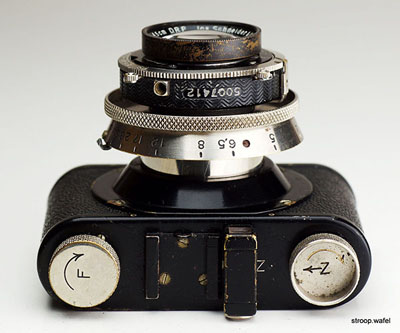
|
Top view of the Gewirette with helical focus mount. Note that the lens was collapsible just as it was for the regular front-cell focusing version. You'd be hard-pressed to find a faster lens in a smaller package!
|
To load film one had to remove the top housing and insert the film with the lead-in wound onto the uptake spool. It was rather fiddly to get it all aligned correctly so that the top housing would properly shut. 127 film is no longer available, it produced (on the Gewirette) pictures of 40x30 mm, slightly larger than 135 film. One could use 135 film with some homemade backing paper and accept that some of the image will overlap the perforations. Alternatively, try to find old expired film or cut your own from 120 roll film. Occasionally Rollei or Efke produce small batches.
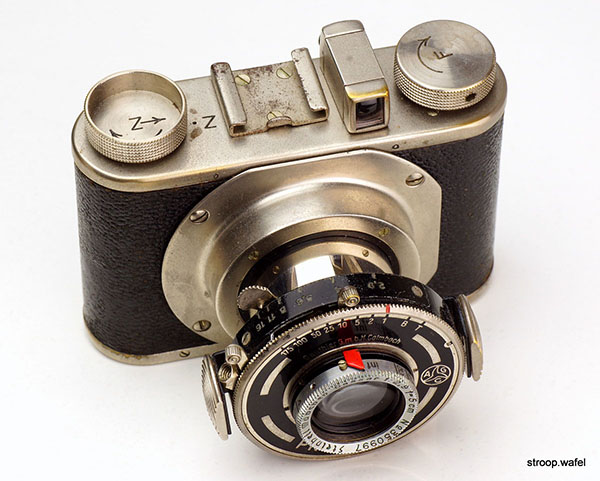
A 'standard' Gewirette v.2 with Prontor II shutter and a Steinheil Cassar lens. An interesting looking font was used for 'Steinheil Munchen' on the lens front ring.
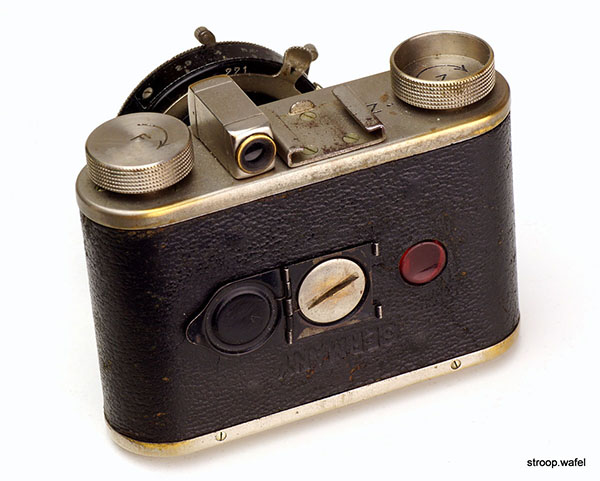
Gewirette seen from the rear showing two red spy windows, the one on the left is covered. There were two windows as 127 film only has markers for 8 and 12 exposures. To get 16 exposures one needed to wind the film until the frame number appears in the right window, then for the next exposure until the same number appears in the left window.

A Gewirette with the top plate removed. An empty film spool is visible where a new 127 film would go.
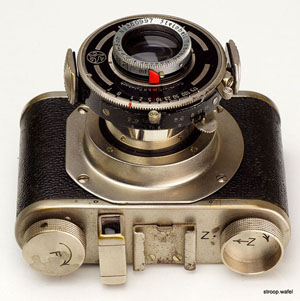
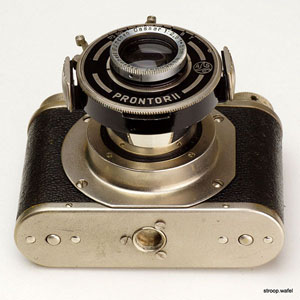
Just a few more photos because it looks so cute!
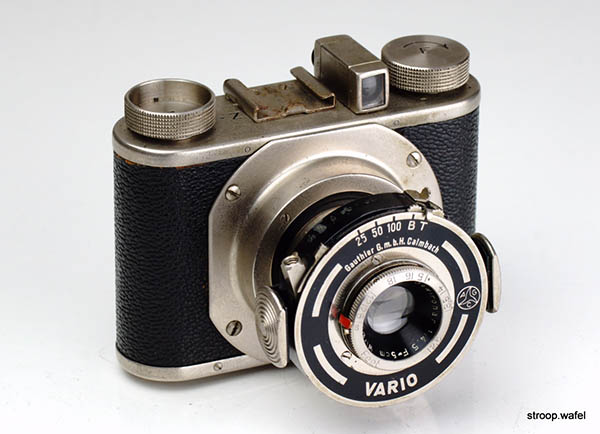
And finally, a variant of the above with Vario shutter and Gewironar 50mm f/4.5 lens.
Adox Adoxette
As mentioned in the introduction, when the Wirgin brothers fled Germany in 1938, the company was taken over by Adox. The Gewirette was renamed the Adoxette, but considering its rarity it was probably produced in only very small numbers. Although very similar, it can be distinguished from the Gewirette by its wind knobs, which had conical indents on top. Also, arrows to indicate the wind directions were engraved on the body, not on the knobs themselves. The name Adox was usually stamped in the leather at the back of the camera.
When Wirgin reclaimed their factory after WWII, no more Gewirette were produced, so the Adoxette was the last version of this model.

An Adox Adoxette with Meyer Gorlitz Trioplan 50mm f/3.5 lens in Prontor II, the most common lens-shutter combination of this model.
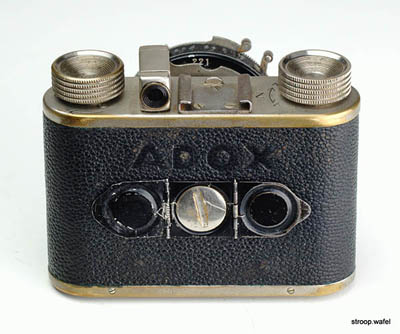
|
Apart from the conical wind knobs, most Adoxettes are most easily identified by the name ADOX stamped in the leather at the back of the camera.
|
|
A different Adoxette, this one with Adox Adoxar 50mm f/4.5 in Vario shutter. This example does not have the name ADOX on the back, perhaps because the name is already on the lens.
|

|
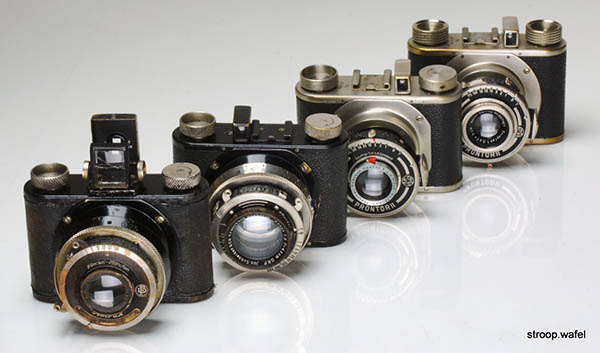
My Gewirette/Adoxette collection together in chronological order.
The Edinex was Wirgin's first camera that used 35mm film. The design was clearly based on that of the Gewirette with its collapsible lens. The Edinex had a characteristic body shape with thick round edges which make the camera nice to hold. Quite a few versions exist, including ones with a coupled rangefinder and one with a fixed (non-collapsible) lens. Unfortunately the nickel plating of the early cameras was of poor quality so these days it is difficult to find examples in good condition. The cameras were bottom loaders and it was fiddly to get the film properly inserted over the sprocket wheels. Later models had doors at the back which made film loading much easier.
Wirgin Edinex (v.1)
The first Edinex model, introduced sometime in the mid-1930s, had a flat top plate with a small viewfinder, two wind knobs, a frame counter and two little wheels that served as a rewind switch and a double exposure prevention reset, respectively. In addition there was a rather odd-looking accessory post next to the viewfinder to which a rangefinder could be fitted.
The camera was available with a range of lenses, including well-known ones like a Schneider Radionar, Steinheil Cassar, Meyer Trioplan, or very rarely a Schneider Xenon, but also more exotic ones like a Ludwig Victar or Laack Egotar, as well as Wirgin own (rebranded?) Gewironar. Shutters were usually a Pronto II but Vario, Compur and Compur-Rapid shutters can also be found. Some versions had a depth of field table on the back, others a door that made film loading easier. Most had front cell focussing but there are examples of helical focussing with the focus ring attached to the lens base. It was marketed in the US as the Candid Midget and Midget Marvel, although these names only appear in ads, the cameras were branded Wirgin.
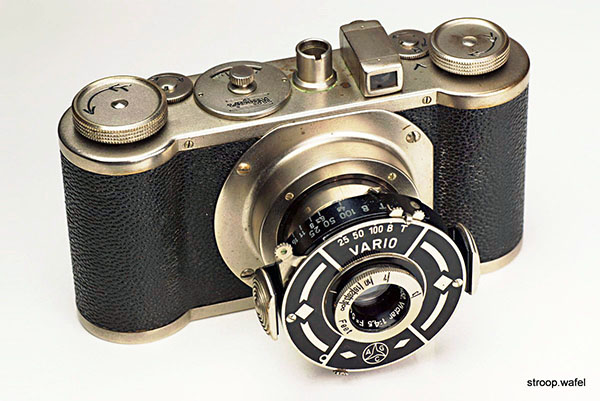
A pre-war Wirgin Edinex with rather rare Art Deco style Vario shutter and Ludwig-Dresden Victar 5 cm f/4.5 lens with focus scale in feet. I have only seen this style in American ads for the Candid Midget and Midget Marvel, so perhaps this was an export-only version.

A very similar Wirgin Edinex, here with Meyer Trioplan 50mm f/2.9 lens in a regular Prontor II shutter. Based on the lens serial# it was produced in mid 1936.
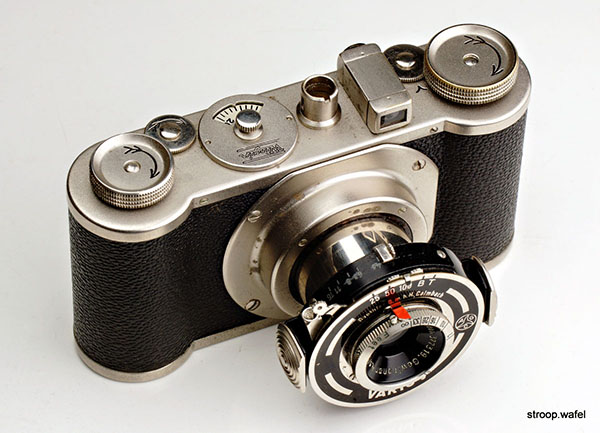
A pre-war Wirgin Edinex with Wirgin-Wiesbaden Gewironar 50/4.5 lens. It differs from the two above in its film transport. Note that on this example the wind knob needed to be rotated clockwise, whereas on the examples above it was counterclockwise. Thus, the film was wound in a different way onto the wind spool. Presumably this change was made to improve the connection between the film and the sprocket wheel.
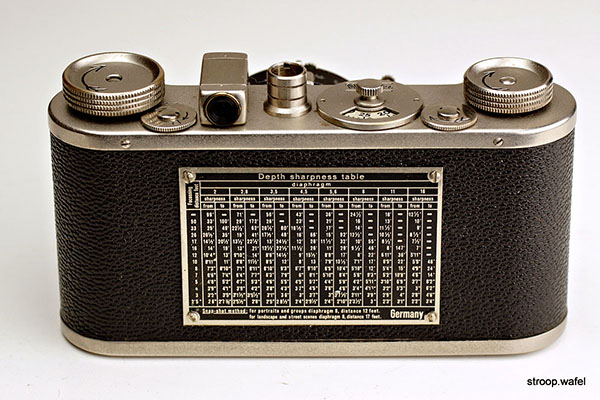
Rear view of the same Wirgin Edinex showing the depth-of-field table at the back. Earlier models like the other ones above lacked this table, whereas later models had hinged or removable backs to aid film loading.
In addition to the range of lenses, shutters and camera back designs, several body variants existed. The first had flat wind knobs with a small ridge and arrows indicating wind direction. This is a pre-war version based on the serial numbers of Schneider Xenar and Xenon lenses (1936-1938). A later version had serrated wind knobs with a conical indent and a door at the back. This was a post-war version from around 1948-1949 based on serial numbers of Schneider Radionar lenses most common on this model. Curiously, the little rewind and double exposure rest wheels swapped place compared to the first version.

A post-war Edinex with Schneider Radionar from mid-1949.
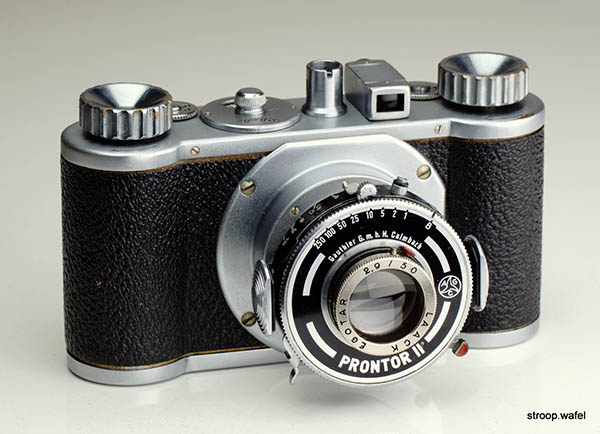
A post-war Edinex with a rather unusual lens, a Laack Egotar 50mm f/2.9. The main other difference with the example above is that this one is chrome-plated instead of nickel-plated (but the opposite is true for the lenses!). Laack was a small German lensmaker, its lenses could amongst others also be found on the Altix Altissa I (Laack Pololyt) and Altissa III (Laack Tegonar) as well as several box and TLR cameras. The Wirgin brothers certainly had a soft spot for weird and wonderful lenses!
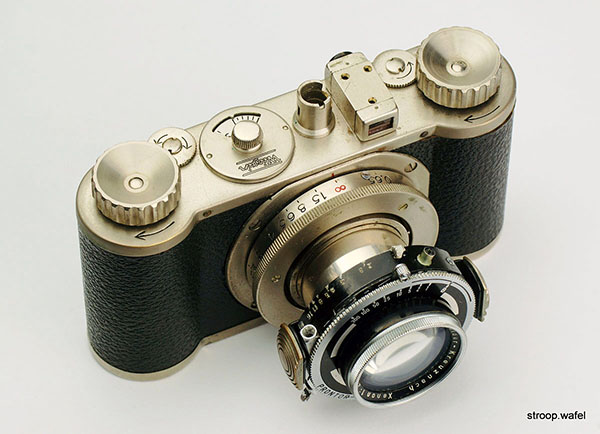
A post-war Edinex with Schneider Xenon 50mm f/2 lens from late 1948. This example has a rare helical focussing mount instead of the more common front-cell focus. It allowed closer focussing down to 60 cm or 2 feet.
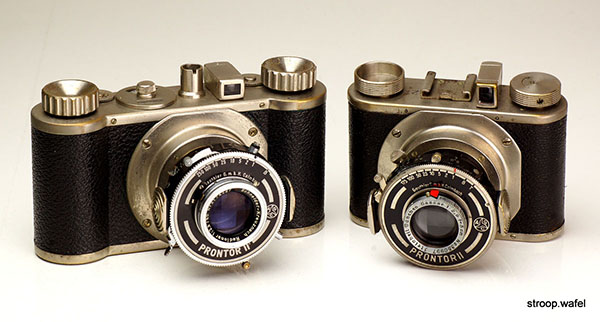
An Edinex and Gewirette together, quite a difference in size! It is rather counterintuitive that the smaller camera had the larger film frame (3x4 vs 35mm).
An even later version had a completely round lens mount instead of the cut-off version on the earlier variants, and the serrated wind knobs were now flat with engraved concentric rings. This is a version from around 1950 based on serial numbers of the Cassar lens, which are similar to those from the Regula IP.
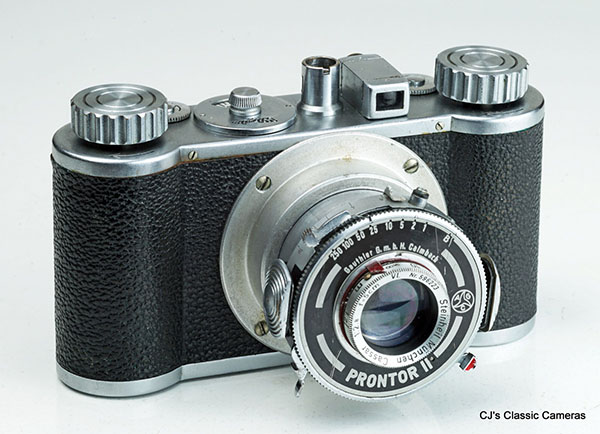
The final version of the first Edinex model with Steinheil Cassar 50mm f/2.8 lens. The serial# of this Cassar (596223) is not much lower than the Edinex v2 below (616838). It's also one of the last cameras to come with a Prontor II shutter, before being replaced by the Prontor-S.
Adox Adrette
As mentioned in the introduction, when the Wirgin brothers fled Germany in 1938, the company was taken over temporarily by Adox. The Edinex was renamed to Adrette and was produced in two different version, one with helical focus mount (Adrette II) and one with front-cell focussing (Adrette I). Although the earlier Edinex was also available as a helical focus version, the Adox variant seems to be much more common. The Adrette was very similar to the Edinex, but (like the Adoxette, the Adox version of the Gewirette) could be recognised by its wind knobs, the top of which had conical indents (with some exceptions). In addition, the frame counter was marked 'Adox' instead of 'Wirgin'. Also, the removable back door, aiding film loading, appears to be first introduced on the Adox version.
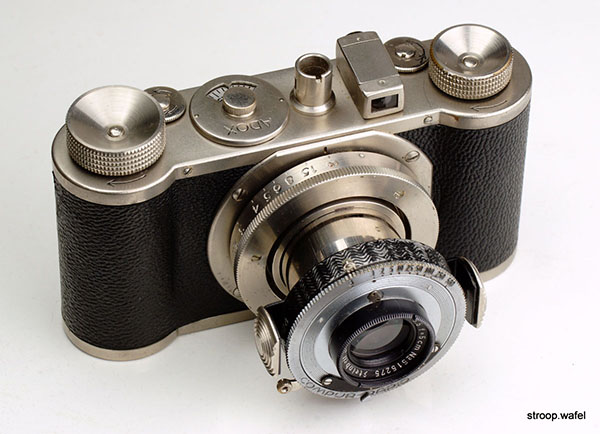
An Adox Adrette II with Steinheil Cassar 50mm f/3.5 lens in a helical focus mount and Compur-Rapid shutter.
Quite a few variants exist, mainly differing at the back side. Some Adrettes had a door to aid film mounting, others had a depth of field table, whereas some just had a blank back with only a screw hole to aid focus alignment. These different backs could also be found on various Edinex variants, but appear to have been characteristic for different years of production (see above), so it is a little surprising to see the older types re-appear on the Adrette. Perhaps Adox was trying to reduce old stock at a time that new materials were getting scarce due to the German war effort.
After WWII one of the Wirgin brothers soon returned to reclaim his factory and restart the production of Edinex cameras (see below). However, it is clear from lens and shutter serial# that there was a considerable post-war Adox production, and possibly up to one third of Adrettes is from this period.
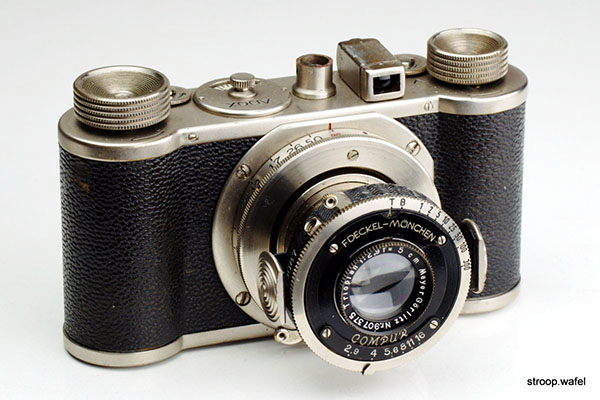
A slightly different Adox Adrette II. Apart from this one having a Meyer Trioplan 50mm f/2.9 lens in Compur shutter, there are some subtle differences with the one above, including the wind knobs, which have grooves on the inside on this example, and the focus ring, which has the distance numbers facing the other way. In addition, this example has a depth-of-focus table at the back, whereas the example above has a hinged backdoor instead.
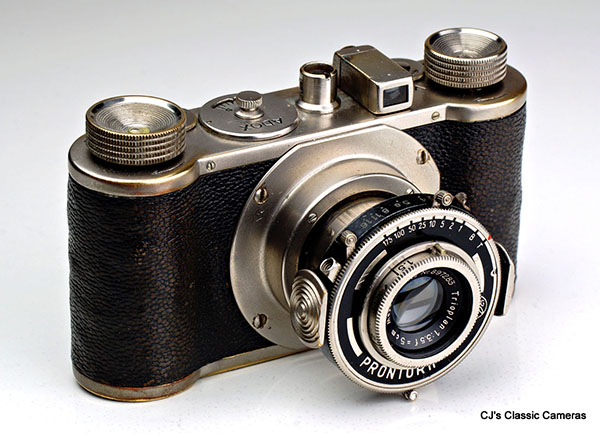
An Adox Adrette I with front-cell focussing Meyer Gorlitz Trioplan 50mm f/3.5 lens in Prontor II shutter. This example has a plain back with only a small screw that can be removed to aid adjusting the lens focus.

A different Adox Adrette I with front-cell focussing Schneider Radionar 50mm f/2.9 lens in Compur-Rapid shutter. A little unusual about this example are the wind knobs, which look like the ones on the first Edinex model but without the engraved arrows these usually had. Thus, one would be tempted to think this was an early production model. However, the back has a hinged door, which is more commonly found on later models and appears to have been introduced on the Adrette first, before the Edinex. This is also consistent with the date of the lens, which is late or perhaps even after WWII.

Yet another Adrette I, you may get tired of them, but I never do :-) This one has an Adox Wiesbaden Adoxar 50mm f/4.5 lens in Vario shutter.
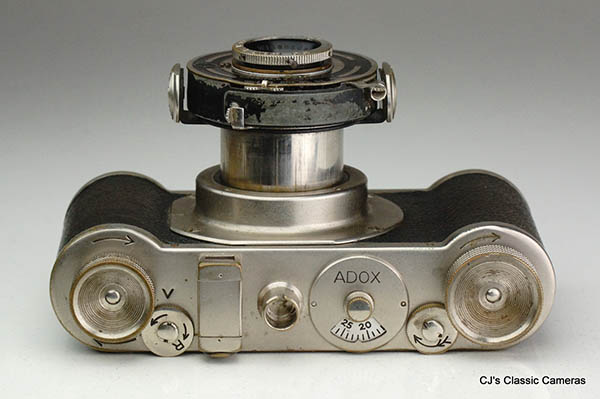
Top view of the same Adrette I, showing the various controls. In addition to the wind knobs there are two smaller dials. The one on the left is the rewind dial, it needs to be turned until the 'R' is opposite the 'v'. I've been pondering what the 'v' meant until I realised it's just an indicator. The small dial on the right is the double exposure block release, basically you need to turn it a little to the left to be able to advance the film to the next frame.
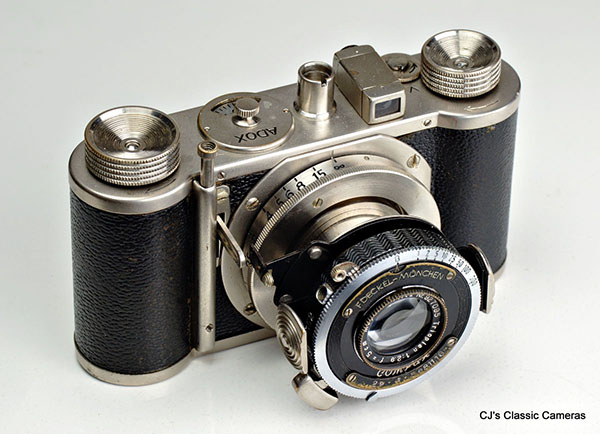
An Adox Adrette II with a rather unusual body-mounted shutter release system. I have seen several examples like these; as the shutter release is fully integrated into the wind mechanism, including the double exposure prevention, it appears that these were made or later upgraded in the Adox factory (instead of being aftermarket additions). Unfortunately a small part linking the shutter release to the body is missing on this example.
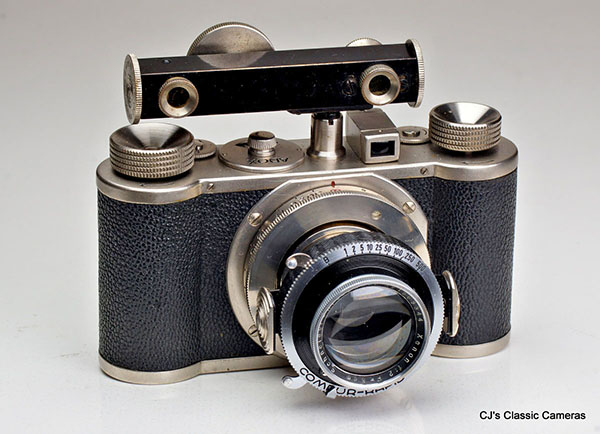
This Adox Adrette II with Schneider Xenon 50mm f/2 lens is almost certainly from post-WWII production. It is shown here with a push-on rangefinder mounted on its accessory post.
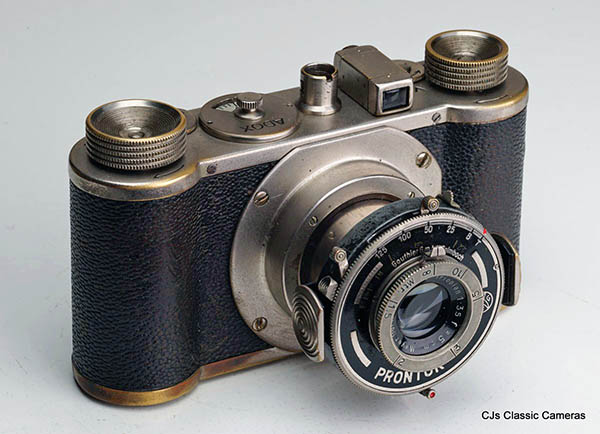
The list of endless variants of the Adrette continues with an example with early Prontor shutter and Meyer Trioplan f/3.5 lens with characteristic focus ring.
Wirgin Edinex (v.2)
The Edinex v.2 had a viewfinder integrated in an elevated part of the top housing together with an accessory shoe. It was very similar to the Edinex I below, but on the front it just says Edinex. Some websites call this the Edinex II, but I don't think it was never marketed as such. The main difference with the Edinex I was that this model did not yet feature a body-mounted shutter release. Like the earlier Edinex, this model was available with a plethora of shutter and lens options. Some body variants exist, for example some had the same lens base as the last variant of the Edinex and a hinged back plate, whereas other ones had a tapered lens base and a removable back plate. Most had grooved wind knobs, but some (early?) ones had serrated knobs like the last variant of the Edinex v.1. A rare version with helical focus mount, most commonly with Schneider Xenon lens in Compur-Rapid shutter, was also available.
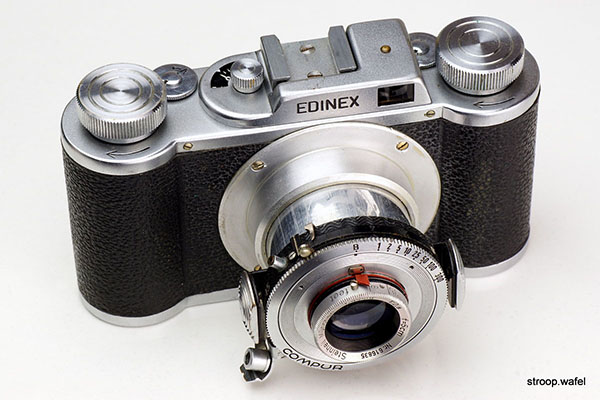
Early version of the Wirgin Edinex v.2 with Steinheil Cassar 50mm f/2.8 and Compur shutter. Note the shutter release lever, which allowed a remote release to be mounted.

Top view of the same camera to show the extension of the lens tube. The enigmatic wheel below the rewind knob is still there.
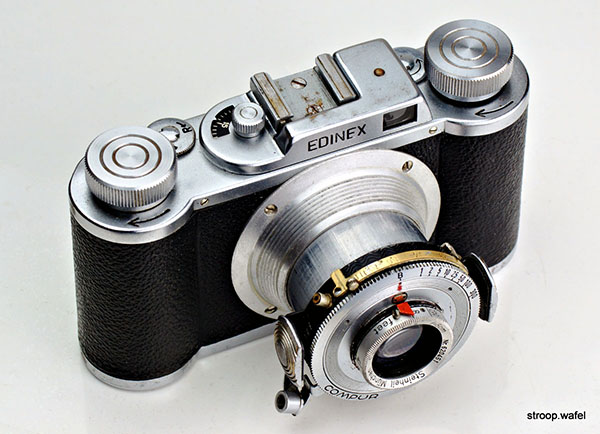
A very similar Edinex as the one above, but here with tapered lens base.
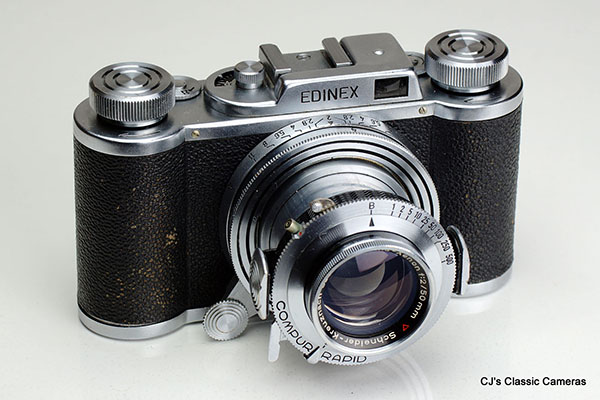
Yet another version, this one rather unusual with helical focus mount and a Xenon lens in Compur-Rapid shutter. As this lens is a Retina-Xenon, it is clearly not original and most likely sourced from a Retina IIa. Perhaps the original Xenon got damaged?
Wirgin Edinex I
The Edinex I was very similar to the Edinex v.2 but had a body-mounted shutter release. However, the shutter still had to be cocked by hand. The little wheel below the rewind knob had now gone, as releasing the shutter would also reset the double-exposure protection mechanism.
There appear to have been three different variants. The first had a tapered lens base and an Edinbar lens in Prontor-S shutter. Early production of this variant had a Leica-style remote release socket and a hinged back, whereas later production had a screw-in remote relesae in the shutter button and a removable back plate. The second variant was similar to the late production of first variant but had a Staeble Kataplast lens in Compur shutter. The third variant had a straight lens base and a Radionar lens in Prontor-S shutter. In addition, it had a ring around shutter as commonly seen on the Edinex III rangefinders (see below).
Although one would expect that the Edinex I postdated the Edinex v.2, it appears this was not the case. When comparing lens serial# on both models, the Edinex I lenses nearly always predate those on the Edinex v.2. My best guess is that both models were introduced around the same time (ca. 1950) and that the Edinex I was only build for one or two years, whereas the Edinex v.2 was in production a few years longer.

The Edinex I with body-mounted shutter release. This is an early production example of the first variant with Wirgin Edinar 50mm f/2.8 lens in Prontor-S shutter and a Leica style remote release socket.

Second variant of the Edinex I with Staeble-Werk -R- Kataplast 50mm f/2.8 lens in Compur shutter.
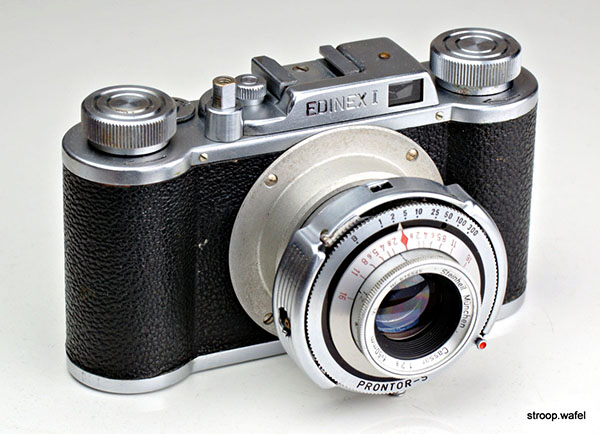
Third variant of the Edinex I, in this case with Steinheil Cassar lens although more commonly found with Schneider Radionar. There are several differences with the other variants above, including the ring around the shutter (more commonly seen on the Edinex III models, see below) and the straight lens base.

Same variant as above, here with the more commonly found with Schneider Radionar. The lens serial# can be dated to early 1951. The shutter is missing the depth-of-field scale of the examples above, so this example probably predates the others.
Wirgin Edinex S
A rare variant of the Wirgin Edinex v.2 with a non-collapsible lens was called the Edinex S. It had a body styling which reminds a little of the Altissa Altix IV, especially when seen from the front. On Camerapedia it says that this was the last version of the Edinex (citing McKeown's) but there is an Edinex-S with a Steinheil Culminar lens which predates all Wirgin Edinex v.2 with Steinheil lenses I have seen. Unfortunately most Edinex-S have Edinar lenses without serial# so it is hard to be certain of their age.
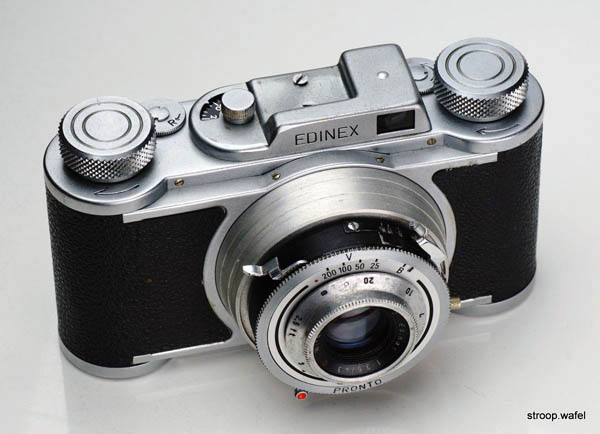
Wirgin Edinex S with Edinar 43 mm f/3.5 and Pronto shutter. This was the only Edinex version without collapsible lens, apart from that it was identical to the Wirgin Edinex v.2 above. The accessory shoe is missing on this example.
Wirgin Edinex III
The Edinex III was the top model of the Edinex series. It featured a coupled rangefinder and had a a collapsible lens with helical focus mount. It dated from around the same time as the Edinex I (ca. 1951). Compared to that model the wind knobs were made larger but still a little difficult to turn due to the size of the rangefinder unit. The shutter housing had a metal ring around it. The Wirgin Edinex III came with a Schneider Radionar, f/2 Xenon or f/2 Rodenstock Heligon lens in Prontor-S or Compur-Rapid shutter. Several changes were made during production, for example, some examples had a one-piece bottom plate which needs to be removed to load film as well as a hinged back door, whereas others had a hinged bottom door but a back door that is not hinged but comes off in its entirety.

A Wirgin Edinex III with Schneider Radionar f/3.5 lens in Prontor-S shutter. This example has a hinged bottom plate instead of the removable bottom plate that most Edinex cameras had.
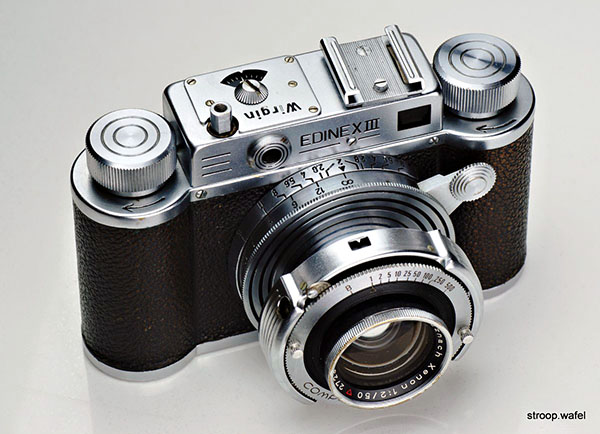
A Wirgin Edinex III with Schneider Xenon f/2 lens in Compur-Rapid shutter.
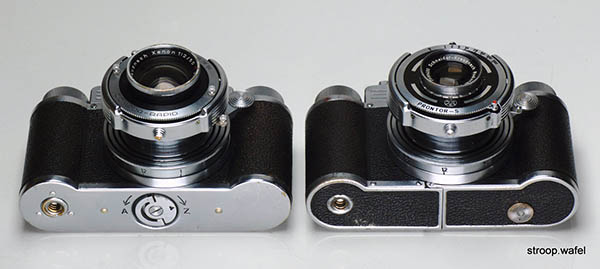
Bottom view of two Wirgin Edinex III showing the difference in bottom plates. The one on the right is the only Edinex with hinged bottom door I have ever seen.
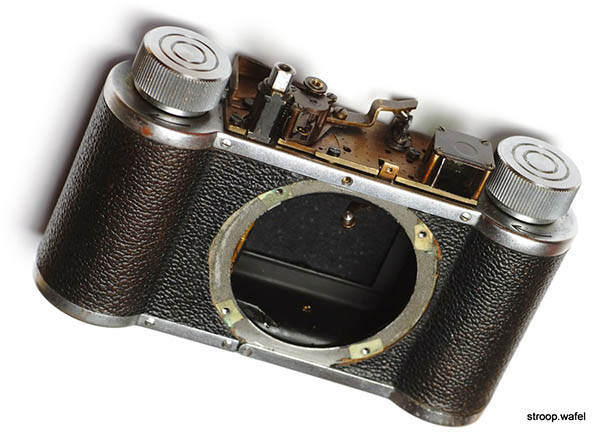
A Wirgin Edinex III with lens and top cover removed. The rangefinder cam is visible in the lens mount opening. Pushing it moves the lever connected to the rangefinder mirror visible at the top of the camera. A small chrome screw allows for horizontal alignment of the rangefinder.

The same camera with lens and top cover back on with only the frame counter removed. The small screw next to the release button allows vertical alignment of the rangefinder. Unfortunately this part is difficult to remove without removing the top housing first, which itself requires the lens base to be unscrewed as it covers one of the top housing screws.

This is a somewhat enigmatic version of the Edinex III. On the front it is marked Edinex only, without the III. There are a few small other differences with the regular Edinex III. This model has a small frame around the viewfinder window and it has a white frame counter instead of a black one. In addition, the wind knobs have much coarser grooves, not unlike the pre-war Edinex. The rangefinder assembly is also slightly different: instead of the rotating mirror of the regular Edinex III it has a small moving lens in the beam path and a fixed mirror. Was this perhaps an early (i.e., first) version of the Edinex III?
Wirgin Edinex III-S
A second version of the Edinex III did not have 'Edinex III' engraved on the front and had three rectangular windows at the front, all of different size, and two eye pieces at the back. Apparently it was called the Edinex III-S although I have found no documentation by Wirgin to support this. The rangefinder was separate from the viewfinder on this model and it lacked the body shutter release. One would therefore expect this to be an earlier model than the Edinex III above, but lens and shutter dates suggest it was actually a later model (1952-1953). A very peculiar feature of the rangefinder was that the windows simply were just holes and contained no lens or glass panes.

An Edinex III-S with Steinheil Cassar lens in Prontor-SV shutter. Only a small engraving on the shutter plate below the lens identified this model as a Wirgin camera. The rangefinder did not work properly on this model, the image moves when focussing the lens but there is no stationary image to match. I suspect perhaps the semi-transparent mirror has been recoated with a non-transparent layer. UPDATE: see picture of rangefinder below.
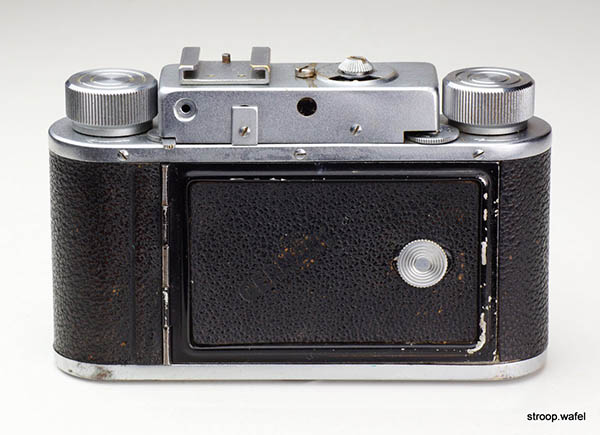
Rear view of an Edinex III-S showing the miniscule eyepiece, which was in fact just a hole and contains no lens. Behind the screwed-on bit of metal was a rangefinder adjustment screw to adjust the horizontal alignment.
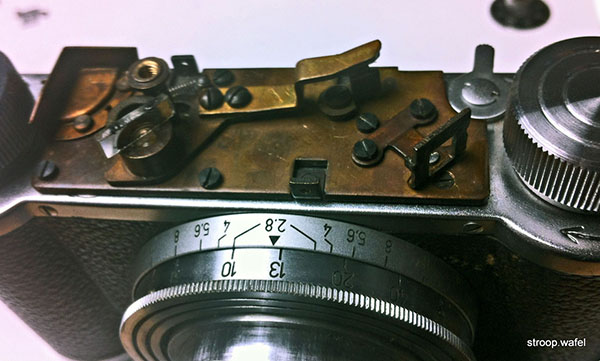
When I finally managed to remove the top cover of this Edinex there was indeed a problem with the mirror. However, it appears that this was a split screen rangefinder, so instead of a semi-transparent mirror there would have been a narrow non-transparent mirror with a small window above it. The mirror that was mounted covered the window and therefore it did not function properly.
The cam system was similar to that on the Edinex III. However, the vertical alignment was adjusted with a screw in the bottom of the mount of the mirror on the right (mirror not present in this photo).
The Edixa had a completely new camera design with the aim to replace the Edinex series. It first appeared in 1953 under the name Edina, but that name was soon after changed to Edixa. It had a lever winder which automatically cocked the shutter and either a viewfinder (Edixa I) or a coupled rangefinder of the split image type (Edixa II). It had a hinged back for easy film loading. Compared to the unique design of the Edinex series, the Edixa was rather middle-of-the-road.
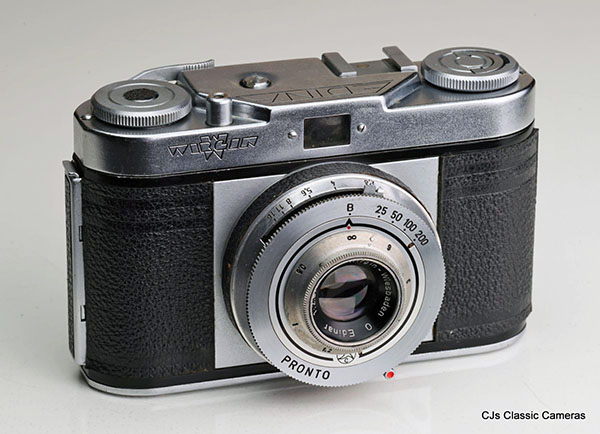
An Wirgin Edina with Edinar 43mm f/2.8 lens, which could also be found on the Edinex (see e.g. the Edinex-S above).
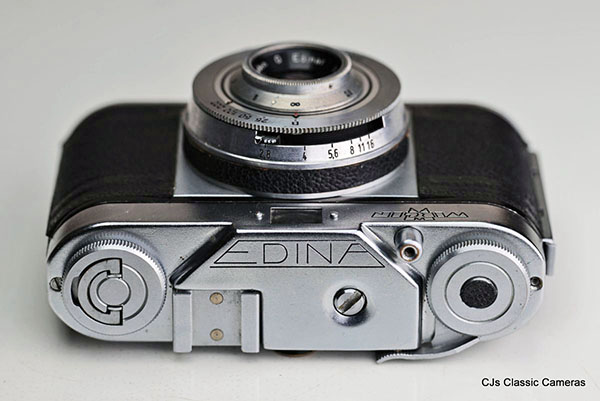
Top view of the Wirgin Edina, which was only produced in 1953, after which the name was changed to Edixa. Interestingly, the instruction manual also showed a rangefinder version, the Edina II, but it appears the name was changed before it was introduced, as I have never seen one.
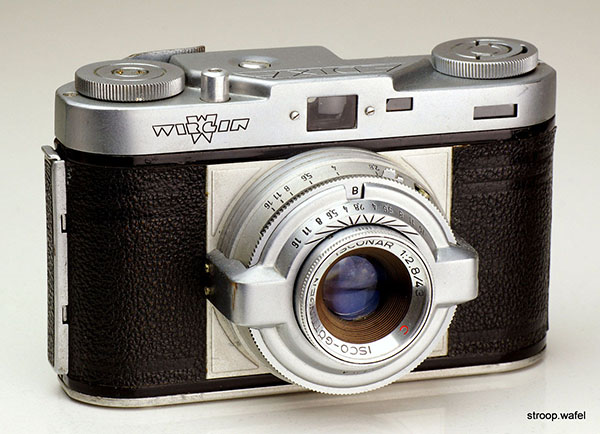
An Edixa II, which was the rangefinder version of the Edixa. The rangefinder lever is hidden below the bar that crosses the lens mount. It has a separate viewfinder window for composing the photograph. This example has an Isco Isconar 45mm f/2.8 lens, like most of the Edixa IIs, but apparently they were also available with Steinheil Cassar.

A slightly different rangefinder variant, the Edixa II-L, from around 1957. It had the same rangefinder as the Edixa II, but a different coupling mechanism to the lens (note the rotating knob beneath the lens and the lack of 'cross bars'). It also had a film indicator dial integrated in the rewind knob. This model appears to have been sold with Isco Westanar 45mm f/2.8 lenses in Prontor-SVS shutter only, so was of better specification than the earlier model.
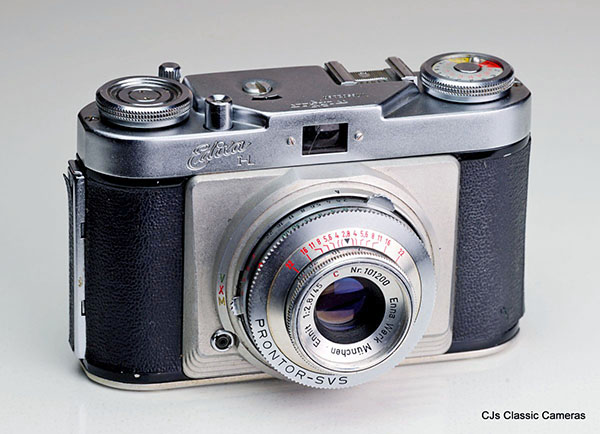
There was also a viewfinder version of the above rangefinder, the Edixa I-L. This example has an Enna Ennit 45mm f/2.8 lens in Prontor-SVS shutter, which compares favourably to the shutters and lenses on the earlier Edixa/Edina model.
A problem with servicing these cameras is that it is virtually impossible to remove the windlever, which is neccessary to take the top off. The small screw in the middle of the windknob with two little holes in it is incredibly tight, and in fact I failed to remove it on any of the Edixas shown here. I am not the only one, as often they are badly scratched by toolmarks.
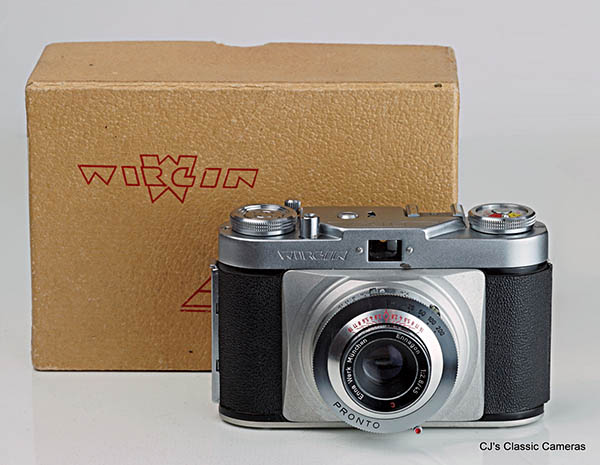
And here's a later version of the original Edixa, very similar to the Edixa I-L above, to the point that's it's not clear to me why this was introduced as a separate model. Differences appear to be cosmetic only, apart from the cheaper lens-shutter combination. It's shown here with its original box.
The Wirgin Stereo was modelled on the Edixa and looked fairly similar to the Iloca Stereo cameras elsewhere on this site. It had less of the Iloca's quirks though, the viewfinder was conveniently placed at the top side of the camera and it had a standard wind lever that forwarded the film in several strokes. The lenses were focussed by use of a single focus lever and aperture and speed settings were linked through a gear system. The camera used the 5-sprocket system (see Iloca Stereo page) and had a 24x24mm frame size. It appears that all Stereo versions came with Steinheil Cassar lenses. Versions with rangefinder plus or minus uncoupled light meter were also available (see below).

A Wirgin Stereo with a pair of Steinheil Cassar lenses in Vario shutter.
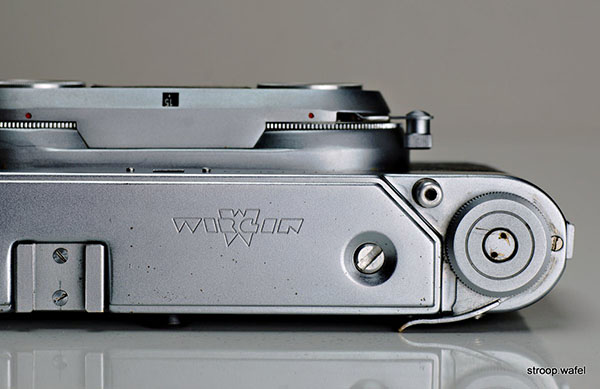
Top view of a Wirgin Stereo. The metal parts had a slight roughness resulting in a matte finish, in contrast to the shiny chrome of many contemporary cameras.
The Wirgin Stereo went through a few design changes, first it was marked 'Edixa Stereo' instead of just 'Stereo', later it received a slightly shorter and stubbier wind lever, a depth of focus scale on the lens with the focus lever and finally a film reminder dial integrated in the rewind knob. In addition, a rangefinder version was introduced, the Edixa Stereo IIA, as well as a version with uncoupled lightmeter in addition to the rangefinder, the Stereo Edixa IIIA.
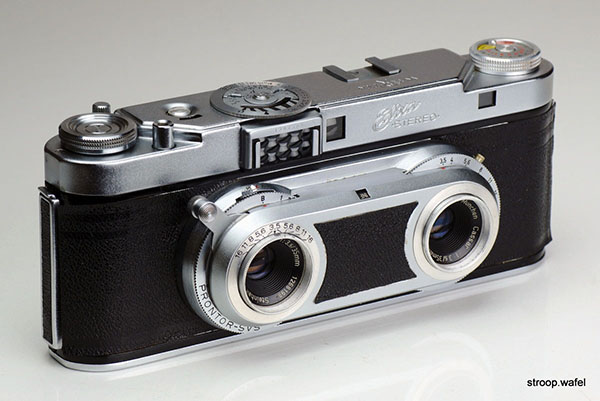
A Wirgin Edixa Stereo with rangefinder and uncoupled lightmeter. This example has a serial number engraved on front of the lightmeter, it is unclear to me if this refers to the camera or the lightmeter itself.
The Edixa 16M is the first, and so far only, 16mm camera on this site. I have a Kodak Ektra which I bought very cheaply just to get a 110 film cassette (cheaper than buying film separately!) but that is little plastic toy in comparison and hardly worth writing about. The Edixa 16 was in a completely different league. It was a beautiful piece of engineering and finished to a very high standard.
16mm cameras were a group of subminiature still cameras that had the use of 16mm wide film as a common denominator. There was, however, a wide range of image formats as well as film types, e.g., perforated, non-perforated, paper-backed, and any many types of cassettes. It wasn't till 1972 when Kodak introduced the 110 film cassette that some sort of standardisation was achieved. Due to the small film size the cameras were very light and compact and thus very popular for holiday snaps etc. An enormous range of cameras was produced between the 1950s and 1970s, after which their popularity subsided due to cameras with superior (larger) film formats becoming equally compact.
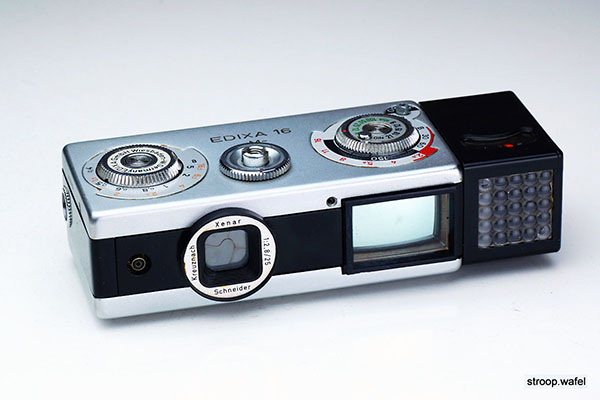
An Edixa II 16 -M-, which had a connection for a coupled lightmeter. This one had an excellent Schneider Xenar 25mm f/2.8 lens. The build quality is demonstrated by the fact that this example was very dirty when it reached me, but nevertheless all controls (other than the lightmeter cell) still worked smoothly and faultlessly.
The first 'modern' 16mm cameras with a typical flat matchbox-style form factor were made in Japan by the likes of Minolta, Yashica and Mamiya. Most German camera makers appear not to have bothered with the 16mm format, but Wirgin came out with the Edixa 16 in 1960. Its designer Heinz Waaske famously moved to Rollei several years later; the Rollei 16 was a clear descendant of the Edixa 16, but also the famed Rollei 35 showed many of the same design features.
The Wirgin Edixa 16 was a true marvel of miniaturisation that had all the features of contemporary 35mm cameras, including lever wind, automatically resetting frame counter, tripod socket, flash sync, a fully focussing lens, and semi-automatic and full manual exposure modes.
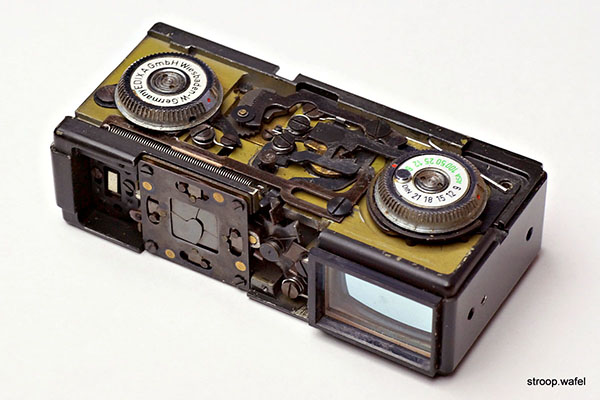
The innards of the Edixa II 16 -M-, a marvel of miniaturisation!
Despite the large range of viewfinder and rangefinder cameras described above, Wirgin was probably most famous for their long-lasting range of SLR cameras, introduced in the early 1950s. Their popularity was probably due to two reasons: first, Wirgin adopted the m42 or Praktika mount for their SLRs, and second, they used a focal plane shutter. Thus, the cameras were similar to the popular Contax/Pentacon and Praktica SLRs (made in East, not West-Germany), and distinct from leaf shutter SLRs like, e.g., the Kodak Reflex range, the Agfa Ambiflex and the Voigtlander Bessamatic, which were more heavy, bulky and complicated. There was one exception: the Edixa Electronica, which was indeed a leaf shutter SLR with a Compur-Deckel mount, the same as used on the Kodak Retina SLR range.
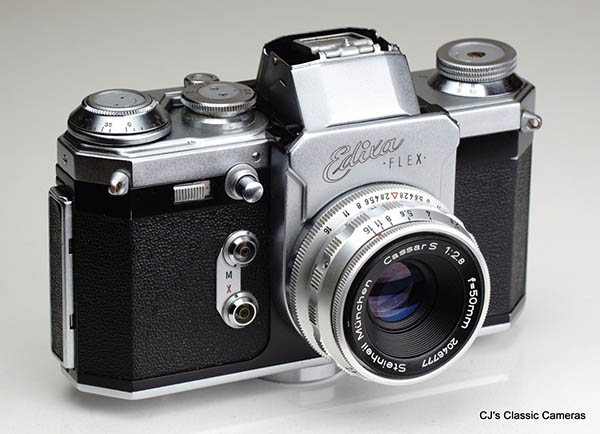
A Wirgin Edixa Flex with Steinheil Cassar 50mm f/2.8 lens and waist-level viewfinder. Not to be confused with the later Edixa-Flex; Wirgin named their SLRs very confusingly. This model was introduced around 1958 and has chrome knobs and levers, which I prefer over the later plastic ones, like one Edixa-Mat Reflex below. I have not been able to work out why some models were called Flex and others Reflex (e.g., there are also a Edixa-Mat Flex and Reflex). However, this particular Flex appears to be a simpler version of the contemporary Reflex models, as it misses slow shutter speeds and the highest speed is 1/500s instead of 1/1000s, it also does not have an automatic return mirror.
The Edixa Reflex range was available with interchangeable waistlevel or pentaprism eyelevel viewfinder, a feature not that common at the time. A confusing array of slightly different models were made, which I have not really managed to make much sense of it as of yet. The Wirgin SLRs were produced until 1971, when the company went bankrupt due to increased competition and lack of innovation.
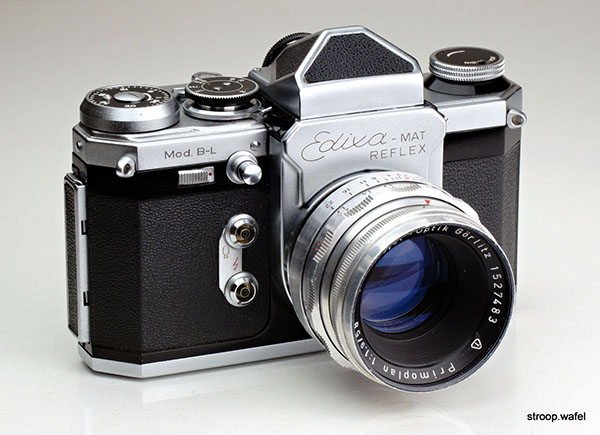
A Wirgin Edixa-Mat Reflex mod B-L with Meyer-Optik Primoplan 58mm f/1.9 lens. I must admit that the lens was the main reason I bought this camera, although I was at the lookout for an affordable Edixa Reflex anyway. This model was introduced in 1963 and featured an automatic return mirror and automatic stopping down of the aperture during shutter release on compatible lenses (not the Primoplan!). It had a shutter speed range from 1 to 1/1000 s.
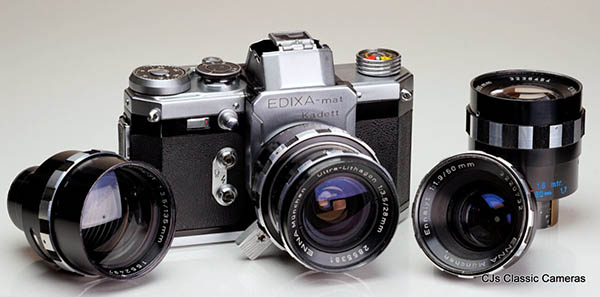
The camera shown here is yet another Wirgin SLR, a Edixa-Matt Kadett in this case, but the main reason for showing it here is the rather unique set of lenses that came with it. They were made by at the time well-known lens manufacturer Enna (who made most of the later Corfield lenses) and consisted of a interchangeable focus mount called 'Sockel' which could be used with a range of lenses of various focal length. One might ask why this was useful, as the lens mount allowed for changing lenses anyway, but the Sockel mount was available for different lens mounts including M42 and Exakta, and thus allowed the same lens to be used on different cameras. I'd still argue that the same could be achieved with a simple mount adapter, but that would only work to fit Exakta lenses on a m42 camera, due to the difference in register distance. So, in summary, the Enna Sockel allowed you to fit m42 lenses onto your Exakta camera, but only the ones that fitted this Sockel mount.
A good range of lenses was available though, ranging from 24 to 240 mm, with a 28mm f3.5 Ultra-Lithagon, a 35mm f/2.8 Lithagon, a 50mm f/1.9 Ennalyt and a 135mm f/3.5 Tele-Ennalyt shown here. As the focus throw of lenses increases with their focal length, a colour-coded distance scale was used to identify which scale was for which lens. However, since these lenses were meant for SLR cameras, the focus scale wasn't that important.
There were two variants of the Sockel with different 'zebra' stripes, with the later version having an automatic aperture but a slightly reduced range of lenses. The one shown here is the first version, the second version had narrower stripes. The two version were not interchangeable.
Sources:
Interesting article about the history of the Wirgin brothers and their company. UPDATE: link is now dead.
| 
